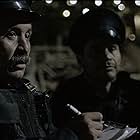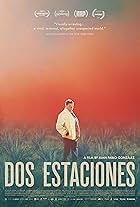Belonging to a community of muxes - untethered by the gender binary - Delirio, Amaranta, Mariano traverse their past, present, and future.Belonging to a community of muxes - untethered by the gender binary - Delirio, Amaranta, Mariano traverse their past, present, and future.Belonging to a community of muxes - untethered by the gender binary - Delirio, Amaranta, Mariano traverse their past, present, and future.
- Awards
- 5 wins & 6 nominations
- Director
- Writers
- All cast & crew
- Production, box office & more at IMDbPro
Storyline
Featured review
The new movie directed by Horacio Alcalá releases the 4th of October, 2021. Finlandia belongs to the genre of magical realism. In my opinion, it has some elements consistent with documentaries related to its genre. It focuses on the muxhe community, a group of Zapotec people who identify as a third-gender, and the journey of Marta, a young designer, who comes to the region of Oaxaca in order to copy local clothing traditions and styles and bring them back to Europe.
The movie has some realistic elements that are related to its setting mostly. The decor has not been altered, and the director shot the authentic streets and places of devotion of the Zapotec people. The viewer enters the world of the inhabitants of Juchitan de Zaragora through the food, life, architecture, and social life on the screen.
In addition to the setting, natural light also adds realism to this story. Most of the scenes are shot outside and illuminated by the powerful Mexican sun, which intensifies the incredible landscape and colors of the muxhes' traditional clothing. Finlandia gives us an upclose insight into the process of creation and production of their designs, which are mostly made by the muxhes themselves.
The cinematic techniques based in magical realism used in Finlandia urge us to dream. Nature has an important role that symbolically shows the emotion of the muxhes and affirms its power through natural events. Some shots reinforce the idea that human beings are a grain of sand compared to the immense might of nature. The wailing wall is shown within a large shot that juxtaposes the size of a human with its own to remind us that we are nothing compared to nature.
Time is often slowed down in order to give a sense of dissolution. This also provides a magical effect while giving intensity to the characters' actions and emotions such as when they're praying to the wall or when Mariano gets bullied. Slow motion is used in a very powerful scene of a dinner between the European which represents a critic from a sophisticated and arrogant world talking down to people living a more simple life.
Catholicism and religious figures are present in the movie as well, and in my opinion, they reinforce these magical and metaphysical aspects. The shots play with these figures by placing Mary between Delirio and Amaranta, and Jesus above them while only displaying their heads.
Finlandia succeeds in being a meaningful documentary of both Mexico and the muxhe culture. It opens our minds and gives us a fair and deliberate vision of Latina America that encourages us to improve our tolerance in the face of difference.
The movie has some realistic elements that are related to its setting mostly. The decor has not been altered, and the director shot the authentic streets and places of devotion of the Zapotec people. The viewer enters the world of the inhabitants of Juchitan de Zaragora through the food, life, architecture, and social life on the screen.
In addition to the setting, natural light also adds realism to this story. Most of the scenes are shot outside and illuminated by the powerful Mexican sun, which intensifies the incredible landscape and colors of the muxhes' traditional clothing. Finlandia gives us an upclose insight into the process of creation and production of their designs, which are mostly made by the muxhes themselves.
The cinematic techniques based in magical realism used in Finlandia urge us to dream. Nature has an important role that symbolically shows the emotion of the muxhes and affirms its power through natural events. Some shots reinforce the idea that human beings are a grain of sand compared to the immense might of nature. The wailing wall is shown within a large shot that juxtaposes the size of a human with its own to remind us that we are nothing compared to nature.
Time is often slowed down in order to give a sense of dissolution. This also provides a magical effect while giving intensity to the characters' actions and emotions such as when they're praying to the wall or when Mariano gets bullied. Slow motion is used in a very powerful scene of a dinner between the European which represents a critic from a sophisticated and arrogant world talking down to people living a more simple life.
Catholicism and religious figures are present in the movie as well, and in my opinion, they reinforce these magical and metaphysical aspects. The shots play with these figures by placing Mary between Delirio and Amaranta, and Jesus above them while only displaying their heads.
Finlandia succeeds in being a meaningful documentary of both Mexico and the muxhe culture. It opens our minds and gives us a fair and deliberate vision of Latina America that encourages us to improve our tolerance in the face of difference.
- How long is Finlandia?Powered by Alexa
Details
Box office
- Gross worldwide
- $7,994
- Runtime1 hour 37 minutes
- Color
- Aspect ratio
- 1.85 : 1
Contribute to this page
Suggest an edit or add missing content

























